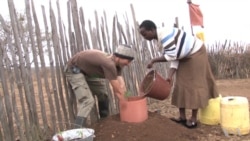In northern Kenya, recurrent drought and desertification [process by which once fertile lands turn into deserts] are hitting livestock-dependent communities hard. Families in the Samburu region are hoping to root out malnutrition by planting 18 species of drought-resistant, fruit-bearing trees.
Early morning in Samburu. Ten-year-old Arlha Lenguris is having her only meal of the day, porridge mixed with cooking oil, before heading out to tend to her father’s herd of goats.
Her father, Mark Lenguris, earns about $100 a month. The family’s diet mainly consists of rice, polenta and beans. It’s what they can afford and what’s available.
Samburu gets low rainfall throughout the year. Drought is common. Herders can travel more than a 160 kilometers in search of green pasture.
"The grazing ground for camel, cattle and sheep is just so scarce so that’s why I’ve thought of some options of farming because there’s no ground to graze nowhere to take our animals to feed grass," said Mark Lenguris.
Lenguris started planting fruit trees about a year ago as part of a U.N.-funded initiative by Sadhana Kenya.
Today, they plant Moringa Stenopetela. Its leaves can be eaten raw or cooked and are good sources of calcium, iron and other key vitamins, like A and C.
“In an area like this, there needs to be more food production, a greater diversity, and with more trees they can provide it, especially [with the] food-producing trees that we plant," said Bruce Thomas, project director with the Sadhana Forest. "With greater diversity, comes greater diversity of nutrition that’s available, and healthier people.”
They are planting other trees also indigenous to the region that need little water, like African oak and desert date trees. The community expects its first harvest in about a year.








